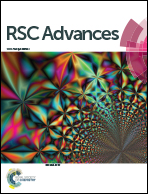Design, synthesis and electronic properties of push–pull–push type dye†
Abstract
A Sonogashira cross-coupling protocol was employed for the construction of a push–pull–push type dye. An ethynyl π-spacer extends the effective π-conjugation length between push and pull units without altering the planarity of the electron donor/acceptor pair. The variation of the strength of the alkyne π-spacer electron push (or donor) units of these dyes has a strong effect on the shifting of both absorption and emission maxima and thereby on the Stokes shift. The dyes were solvatochromic and their solvatochromicity was highly dependent on the electron push unit. Strong red shifted emissions were likely to arise due to the internal charge transfer (ICT) from the electron push unit to the electron pull unit. Calculated energy values of HOMO → LUMO transitions are in good accordance with experimental observations. Alkyne conjugated electron push units (–C![[triple bond, length as m-dash]](https://www.rsc.org/images/entities/char_e002.gif) C–Ar; Ar = Ph, Ph–OMe, Ph–NMe2) are more effective to increase the EHOMO levels. Overall, experimental and theoretical results of the push–pull–push dyes indicate that they can be used as promising conjugated materials with predictable electronic properties for optoelectronic devices.
C–Ar; Ar = Ph, Ph–OMe, Ph–NMe2) are more effective to increase the EHOMO levels. Overall, experimental and theoretical results of the push–pull–push dyes indicate that they can be used as promising conjugated materials with predictable electronic properties for optoelectronic devices.


 Please wait while we load your content...
Please wait while we load your content...